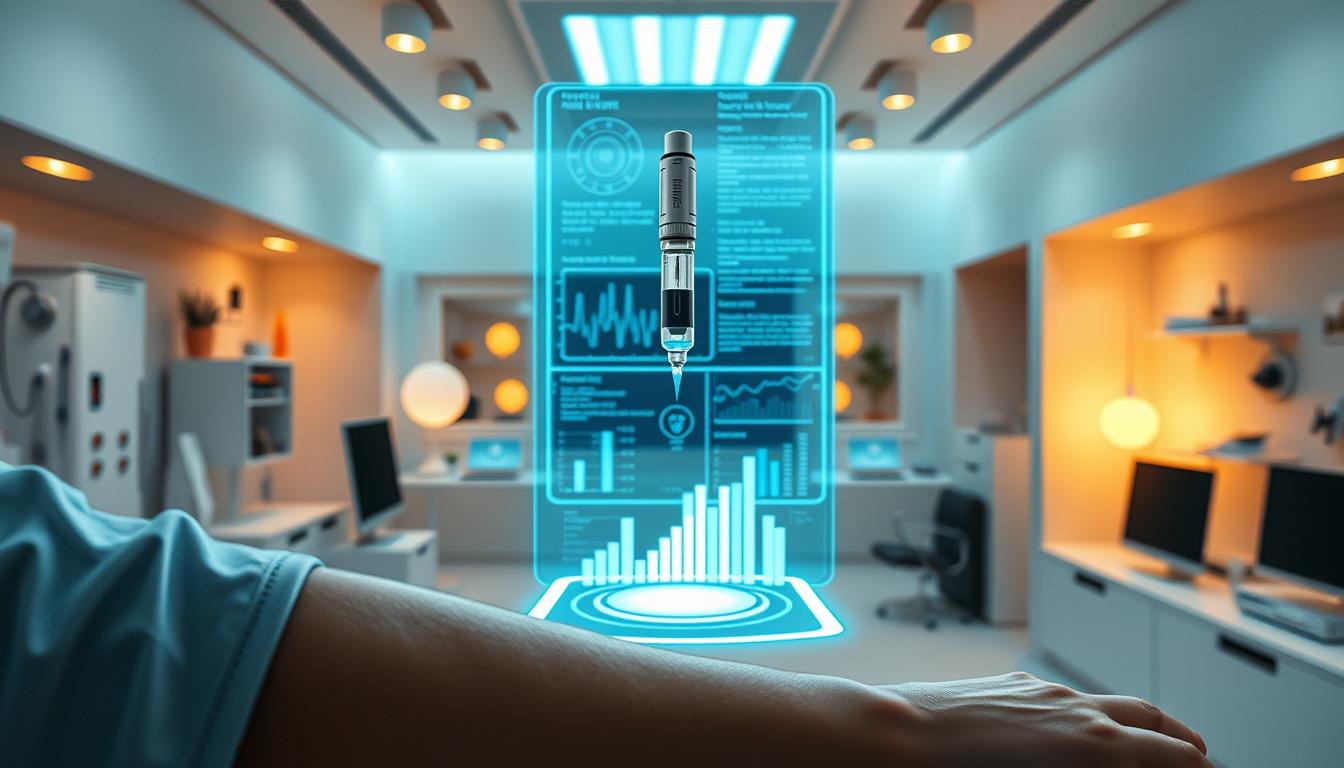Diabetes is changing healthcare, affecting nearly 10% of the world’s population. Artificial intelligence is making a big difference in managing diabetes. It brings personalized insulin automation1.
Advanced closed-loop systems are changing how we deal with diabetes. They offer more precision and control2.
New technologies allow for real-time glucose monitoring and smart insulin delivery. AI algorithms adjust insulin doses automatically. This makes managing diabetes easier1.
With more people using continuous glucose monitoring, blood sugar levels are more stable. This leads to better health outcomes2.
The shift in diabetes care is not just about new treatments. AI uses machine learning and predictive analytics. It helps manage insulin delivery before problems happen1.
This is a big step forward in managing diabetes personally2.
Key Takeaways
- AI is revolutionizing diabetes management through personalized insulin automation
- Closed-loop systems provide real-time glucose monitoring and adaptive insulin delivery
- Machine learning enables predictive and proactive diabetes care
- Advanced technologies reduce manual intervention in insulin management
- Personalized systems improve patient quality of life and health outcomes
Understanding Modern Diabetes Management Challenges
Diabetes is a big challenge for millions of people around the world. It affects more than just health; it changes daily life3.
Traditional Insulin Therapy Limitations
Managing diabetes is a big job. It requires constant attention and tough choices. Traditional insulin therapy has its own set of problems for patients, like:
- Frequent blood glucose monitoring
- Complex insulin dosing calculations
- Risk of hypoglycemic and hyperglycemic episodes
“Managing diabetes is like a continuous mathematical equation involving food, insulin, activity, and stress.” – Diabetes Care Expert
Quality of Life Impact
Diabetes can take a big toll on both body and mind. Patients often feel a lot of psychological stress from always watching their health and worrying about complications4.
Economic Burden of Manual Management
| Cost Category | Annual Expenses |
|---|---|
| Medical Supplies | $3,000 – $5,000 |
| Potential Lost Productivity | $5,000 – $8,000 |
| Total Estimated Impact | $8,000 – $13,000 |
The cost of diabetes goes beyond just medical bills. It also includes lost work time and ongoing treatment costs3.
New tech like continuous glucose monitoring and AI could change the game. They might make managing diabetes easier and better for patients4.
Evolution of Insulin Delivery Systems Through Time
The journey of insulin delivery has been amazing. From the start, doctors tried to mimic the pancreas’s insulin making5. The first closed-loop insulin system came out in the early 1960s, a big step forward5.
Looking back, there were key moments in insulin pump history. In the early 1970s, the first artificial pancreas-like systems were made5. The Biostator, launched in 1977, was a big help in research for decades, leading to over 200 studies5.
- 1960s: First closed-loop insulin delivery system developed
- 1970s: Initial artificial pancreas prototypes created
- 1980s: First wearable artificial pancreas system
- 2009: Low-glucose suspend systems introduced
Things got better fast with important milestones. In 2005, the Juvenile Diabetes Research Foundation started the Artificial Pancreas Project5. By 2016, the MiniMed 670G was the first hybrid closed-loop system sold, a big step in diabetes care5.
“Innovation in diabetes technology continues to transform patient care and quality of life.”
Today, automated insulin delivery (AID) systems aim for at least 70% time in target glucose range4. These systems are the result of years of research and innovation in insulin pump history.
| Decade | Key Technological Advancement |
|---|---|
| 1960s | First Closed-Loop System |
| 1970s | Artificial Pancreas Prototypes |
| 2000s | Low-Glucose Suspend Systems |
| 2016 | First Hybrid Closed-Loop System |
Diabetes technology keeps getting better, offering more advanced and tailored insulin solutions4.
Artificial Intelligence in Diabetes Care: Core Technologies
Advanced technologies are changing diabetes care with AI. Machine learning and deep learning are making glucose monitoring and insulin delivery better6.
AI in diabetes is a new way to care for patients. These smart systems look at complex medical data. They give precise insights and advice for patients7.
Machine Learning Algorithms for Glucose Prediction
Machine learning algorithms are great for predicting glucose levels. They can:
- Analyze historical glucose data patterns
- Anticipate potential blood sugar fluctuations
- Provide real-time risk assessments8
Deep Learning Applications in Insulin Dosing
Deep learning is changing how we dose insulin. These advanced algorithms can:
- Calculate optimal insulin doses dynamically
- Consider multiple physiological factors
- Minimize potential hypoglycemic risks6
Clinical trials show AI systems can keep blood sugar in a healthy range 65-75% of the time. This is a big step forward in diabetes care6.
Natural Language Processing for Patient Education
Natural language processing makes patient education personal. It helps patients understand complex medical info better8.
The future of diabetes care lies in intelligent, adaptive technologies that empower patients and healthcare providers alike.
Automate Insulin with AI: The Rise of Personalized Closed-Loop Systems
Closed-loop insulin systems are a big step forward in managing diabetes. They use artificial intelligence to adjust insulin delivery based on a person’s needs5. This change has made it easier for people with diabetes to keep their blood sugar in check.

The journey of automated insulin delivery started in the 1960s. The first commercial artificial pancreas, the Biostator, came out in 19775. Key milestones include:
- First low-glucose suspend system in 2009 by Medtronic
- Predictive low-glucose suspend systems in 2015
- First commercially available hybrid closed-loop system in 2016
Today’s closed-loop insulin systems, like the Omnipod 5, use advanced tech. The SmartAdjust algorithm calculates insulin doses based on glucose monitoring data9. These systems aim to work like a healthy pancreas, offering better insulin delivery.
| System Feature | Performance Benefit |
|---|---|
| AI-Driven Dosing | 72% Time in Glucose Range |
| Predictive Algorithms | Reduced Hypoglycemic Events |
| Continuous Monitoring | Personalized Insulin Delivery |
The DIY closed-loop movement has also grown, with about 2,000 users worldwide5. This movement is changing diabetes care, making it more precise and focused on the patient.
Components of Modern Automated Insulin Delivery Systems
The world of diabetes care has changed a lot with new technologies. Automated insulin delivery systems are a big step forward. They use continuous glucose monitoring, smart insulin pumps, and AI algorithms to change how we manage diabetes2.
Today, diabetes care is all about smart systems that make life easier for patients. People with diabetes make about 180 decisions every day to manage their condition2. These systems aim to simplify these choices with advanced tech.
Continuous Glucose Monitoring Integration
Continuous glucose monitoring (CGM) is key to these systems. It gives real-time glucose data, helping track and understand glucose levels. The goal is to keep glucose levels between 70–180 mg/dL most of the time2.
Smart Insulin Pumps and Controllers
- Omnipod 5 offers a tubeless insulin delivery system10
- Supports up to 2 mL (200 units) of insulin per Pod2
- Includes cloud connectivity for remote data management2
Algorithm-Based Decision Support Systems
AI algorithms make insulin management smarter by analyzing glucose data and suggesting doses. The Omnipod 5 has a SmartBolus calculator that uses CGM data for accurate bolus doses2.
| Age Group | Time in Range (TIR) | TIR Improvement |
|---|---|---|
| 2-5 years | 68.1% | 10.9% |
| 6-13 years | 68.0% | 15.6% |
| 14-70 years | 73.9% | 9.3% |
These systems show great promise in helping manage diabetes at all ages2. Over 425,000 people with diabetes are already using this technology2.
Clinical Benefits of AI-Driven Insulin Management
Artificial intelligence is changing diabetes care in big ways. It brings better glucose control and better patient results. AI offers personalized insulin delivery that goes beyond old ways of managing diabetes11.
Key benefits of AI in insulin management include:
- Improved glycemic control for all ages
- Less risk of low and high blood sugar
- Better time spent in a healthy glucose range
- Less chance of diabetes-related problems
AI is especially good for kids and teens. Studies show big improvements in how well their blood sugar stays in a healthy range. Kids aged 2-5.9 went from 57.2% to 68.1% in a healthy range, adding 2.6 hours of good blood sugar each day11. Kids aged 6-13.9 went from 52.5% to 68.0%, adding 3.7 hours of stable blood sugar11.
Randomized trials show AI insulin management is promising. These studies found less nighttime low blood sugar and better blood sugar control than traditional pumps11. The smart algorithms help give more accurate insulin doses, making life better for patients9.
AI uses machine learning and predictive models to keep improving diabetes care. It offers new hope for better, more tailored diabetes management12.
Real-World Implementation and Patient Outcomes
Diabetes clinical trials have shown us how AI can change the game in insulin management. These new systems are making diabetes care more precise and tailored to each patient9.
Advanced closed-loop systems have made a big difference for diabetes patients. They help manage glucose levels better through smart monitoring9.
Success Stories from Clinical Trials
Recent studies have shown amazing results in diabetes care:
- Continuous glucose monitoring cuts down on low blood sugar events9
- AI systems make blood sugar targets more accurate9
- Tools for patient self-care improve diabetes control9
Improvement in Time-in-Range Metrics
Clinical trials have shown big wins in glucose management. Closed-loop tech has:
| Metric | Improvement |
|---|---|
| Time in Target Range | 9.1% increase13 |
| Glucose Above Range Reduction | 10.8% decrease13 |
Quality of Life Enhancements
AI in diabetes care is changing how patients feel. Intelligent systems reduce mental burden and offer flexible ways to manage diabetes9.
The future of diabetes care lies in personalized, technology-driven solutions that empower patients.
Safety Considerations and Regulatory Framework
Diabetes technology safety is a top priority. The FDA has strict rules to keep patients safe with new insulin systems14. In 2021, over 100 new AI applications were reviewed by the US FDA14.

- Cybersecurity to protect patient data
- System performance must be consistent
- Glucose prediction algorithms need to be accurate
- Automated insulin dosing must be reliable
Rules for diabetes tech are getting better. In the EU, AI medical tools are rated for safety14. Intelligent medical devices need thorough testing to prove they’re safe and work well.
| Regulatory Aspect | US Approach | EU Approach |
|---|---|---|
| AI Medical Device Classification | Flexible risk-based assessment | Strict multi-tier risk evaluation |
| Clinical Decision Support | Non-urgent advice permissible | Moderate to high-risk classification |
AI is changing fast, and rules need to keep up. Personalized dosing is a new area where rules are still evolving14. It’s crucial for patients and doctors to know what these systems can and can’t do.
Future Developments in AI-Powered Diabetes Care
The world of diabetes technology is changing fast. New innovations will change how we manage diabetes. They promise more personalized and accurate care15.
Emerging Technologies and Innovations
New technologies are changing diabetes care. Some key advancements include:
- AI-powered apps for tracking blood sugar levels16
- Systems that automatically give insulin16
- Advanced algorithms for better diabetes detection16
Digital Health Platform Integration
Digital health is getting better. Over six million people worldwide use advanced tracking systems15. These systems make it easy to share health data with doctors.
Predictive Analytics Advancements
Predictive analytics are making a big difference in diabetes care. Machine learning is helping doctors diagnose and manage diabetes better:
| Technology | Accuracy |
|---|---|
| LightGBM Classifier | 98.1% |
| LSTM Neural Networks | 97% |
| Hybrid Machine Learning | 91.65% |
The future of diabetes care is bright. With more people getting diabetes, technology will keep improving15. Researchers are working on new ways to help patients and change treatment plans.
Overcoming Barriers to Adoption
Getting people to use new diabetes tech is tough. It needs smart plans to get it right. Moving to new insulin systems is hard for both patients and doctors17. Making sure everyone can get this tech is a big problem, especially for those who need it most17.
- High technological learning curve
- Financial constraints
- Limited insurance coverage
- Complex device interfaces
Doctors are key in solving these issues. They can teach patients how to use new tech through targeted training programs18.
| Barrier Category | Impact on Adoption | Potential Solutions |
|---|---|---|
| Cost | High financial burden | Insurance policy reforms |
| Technical Complexity | Patient hesitation | Simplified user interfaces |
| Training | Limited understanding | Comprehensive education programs |
New ways like support groups, online learning, and team healthcare can help17. By tackling these problems head-on, we can make care better and tech work better together.
Conclusion: The Future of Personalized Diabetes Management
The world of diabetes care is changing fast thanks to AI in healthcare. New technologies are making diabetes care more personal. Over 537 million adults worldwide have diabetes, making better management urgent19.
AI-driven insulin systems are a big step forward. They help tackle the tough challenges of diabetes management20.
New tech is changing how patients get care. AI helps doctors give more precise and flexible treatments. This leads to better blood sugar control and fewer health problems19.
By 2050, the number of people with diabetes will hit 1.31 billion. This shows how vital smart healthcare solutions are20.
AI is making diabetes care more personal. It uses advanced analytics, wearables, and health monitoring. This means better care and healthier choices for patients19.
The goal is to create systems that adapt to each person’s needs. This will help lower healthcare costs too20.
As tech gets better, AI diabetes care will too. It offers hope to millions of people. With AI, machine learning, and continuous monitoring, we’re entering a new era of precision healthcare. It helps people manage their diabetes better.
FAQ
What is an AI-powered closed-loop insulin delivery system?
How does AI improve insulin management for diabetes patients?
Are AI-powered insulin systems safe?
What are the primary benefits of automated insulin delivery?
How expensive are AI-powered insulin delivery systems?
Can these systems work with different types of diabetes?
What technologies are involved in these closed-loop systems?
How accurate are AI-powered insulin delivery systems?
What is the future of AI in diabetes management?
How do patients learn to use these advanced systems?
Source Links
- Automated Insulin Delivery – https://www.ajmc.com/compendium/automated-insulin-delivery
- Designing a Closed-Loop Automated Insulin Delivery System: Simplifying Life for People, Including Children, Living With Type 1 Diabetes – IEEE Pulse – https://www.embs.org/pulse/articles/designing-a-closed-loop-automated-insulin-delivery-system-simplifying-life-for-people-including-children-living-with-type-1-diabetes/
- AI-Driven Management of Type 2 Diabetes in China: Opportunities and Challenges – https://pmc.ncbi.nlm.nih.gov/articles/PMC11718508/
- Automated insulin delivery: benefits, challenges, and recommendations. A Consensus Report of the Joint Diabetes Technology Working Group of the European Association for the Study of Diabetes and the American Diabetes Association – https://pmc.ncbi.nlm.nih.gov/articles/PMC9534591/
- Closed-Loop Insulin Delivery Systems: Past, Present, and Future Directions – https://pmc.ncbi.nlm.nih.gov/articles/PMC9207329/
- Artificial Intelligence Algorithms for Treatment of Diabetes – https://www.mdpi.com/1999-4893/15/9/299
- Artificial intelligence powered glucose monitoring and controlling system: Pumping module – https://pmc.ncbi.nlm.nih.gov/articles/PMC10999070/
- Frontiers | Application of Artificial Intelligence in Diabetes Education and Management: Present Status and Promising Prospect – https://www.frontiersin.org/journals/public-health/articles/10.3389/fpubh.2020.00173/full
- Diabetes and artificial intelligence beyond the closed loop: a review of the landscape, promise and challenges – https://pmc.ncbi.nlm.nih.gov/articles/PMC10789841/
- Closed loop systems (artificial pancreas) – https://www.diabetes.org.uk/about-diabetes/looking-after-diabetes/technology/closed-loop-systems
- Artificial Intelligence for Diabetes Management and Decision Support: Literature Review – https://www.jmir.org/2018/5/e10775/
- Artificial intelligence in diabetes management: Advancements, opportunities, and challenges – https://pmc.ncbi.nlm.nih.gov/articles/PMC10591058/
- Enabling fully automated insulin delivery through meal detection and size estimation using Artificial Intelligence – npj Digital Medicine – https://www.nature.com/articles/s41746-023-00783-1
- New regulatory thinking is needed for AI-based personalised drug and cell therapies in precision oncology – npj Precision Oncology – https://www.nature.com/articles/s41698-024-00517-w
- Untitled – https://www.abbott.com/content/dam/corp/abbott/en-us/hub-new/Future-of-Diabetes-Report.pdf
- Artificial intelligence-driven transformations in diabetes care: a comprehensive literature review – https://pmc.ncbi.nlm.nih.gov/articles/PMC11374247/
- The future is here: an overview of technology in diabetes – Diabetologia – https://link.springer.com/article/10.1007/s00125-024-06235-z
- Frontiers | Closed-Loop Insulin Delivery Systems: Past, Present, and Future Directions – https://www.frontiersin.org/journals/endocrinology/articles/10.3389/fendo.2022.919942/full
- Polymeric Particulates to Improve Oral Bioavailability of Peptide Drugs – https://www.openaccessjournals.com/articles/artificial-intelligence-in-diabetes-management-transforming-care-through-technology.pdf
- Exploring the progress of artificial intelligence in managing type 2 diabetes mellitus: a comprehensive review of present innovations and anticipated challenges ahead – https://www.frontiersin.org/journals/clinical-diabetes-and-healthcare/articles/10.3389/fcdhc.2023.1316111/pdf




